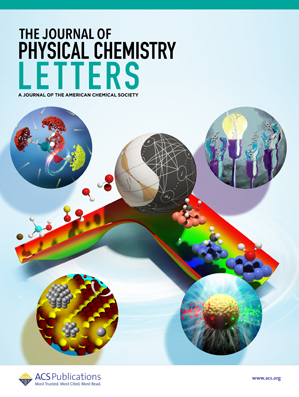Boosting Excitonic Emission in 2D Multiple Quantum Well Superlattices by Plasma-Assisted Electrochemical Intercalation.
IF 4.6
2区 化学
Q2 CHEMISTRY, PHYSICAL
引用次数: 0
Abstract
Scalable fabrication of multiple quantum-well (MQW) superlattices via layer-by-layer stacking of two-dimensional (2D) materials remains challenging. Here, we propose a plasma-assisted electrochemical intercalation strategy to overcome this limitation. By intercalating 1-ethyl-3-methylimidazolium (EMIM+) cations into multilayer molybdenum disulfide (MoS2), followed by oxygen plasma intercalation, we achieve large-area (∼100 μm) MQW superlattices with hundreds of active layers. This approach enhances MoS2 photoluminescence (PL) by 2 orders of magnitude, with the PL quantum yield (PLQY) increasing with both excitation power and thickness. The enhancement arises from interlayer-decoupling-induced bandgap directness and electron extraction induced by oxygen plasma, effectively suppressing charge transfer between heterointerfaces. Our findings provide a scalable route for fabricating quasi-MQW superlattices, opening new avenues for photophysics research and next-generation optoelectronics.等离子体辅助电化学插层增强二维多量子阱超晶格中的激子发射。
通过二维(2D)材料的逐层堆叠可扩展制造多个量子阱(MQW)超晶格仍然具有挑战性。在这里,我们提出了一种等离子体辅助电化学插层策略来克服这一限制。通过在多层二硫化钼(MoS2)中插入1-乙基-3-甲基咪唑(EMIM+)阳离子,然后在氧等离子体中插入,我们获得了具有数百个活性层的大面积(~ 100 μm) MQW超晶格。该方法将MoS2光致发光(PL)提高了2个数量级,且PL量子产率(PLQY)随激发功率和厚度的增加而增加。由于层间去耦诱导的带隙直接性和氧等离子体诱导的电子萃取,有效地抑制了异质界面之间的电荷转移。我们的发现为制造准mqw超晶格提供了一种可扩展的途径,为光物理研究和下一代光电子学开辟了新的途径。
本文章由计算机程序翻译,如有差异,请以英文原文为准。
求助全文
约1分钟内获得全文
求助全文
来源期刊

The Journal of Physical Chemistry Letters
CHEMISTRY, PHYSICAL-NANOSCIENCE & NANOTECHNOLOGY
CiteScore
9.60
自引率
7.00%
发文量
1519
审稿时长
1.6 months
期刊介绍:
The Journal of Physical Chemistry (JPC) Letters is devoted to reporting new and original experimental and theoretical basic research of interest to physical chemists, biophysical chemists, chemical physicists, physicists, material scientists, and engineers. An important criterion for acceptance is that the paper reports a significant scientific advance and/or physical insight such that rapid publication is essential. Two issues of JPC Letters are published each month.
 求助内容:
求助内容: 应助结果提醒方式:
应助结果提醒方式:


